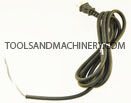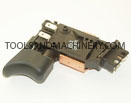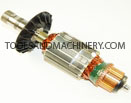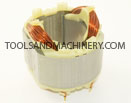A sluggish or sub-par performance is an inevitability in the life of each power tool. However, a little good-old-fasioned fatigue never killed anything, and it certainly isn’t about to drop your power tool. In fact, the diagnosis and solution to your tool’s tired performance is likely just a few simple check points and a small part replacement away.
 Starting with the power cord, simply make sure you don’t have any cuts or breaks; these will prevent electricity from completely flowing into the tool and the tool’s motor. If all looks good with your power cord, our next step is to check your brushes. Although the power switch is the first landing point for the tool’s electrical current, defective brushes are far simpler to detect, and are also more commonly the culprit in a poorly performing power tool, so, for now, we’ll skip the switch and move ahead to the carbon brushes.
Starting with the power cord, simply make sure you don’t have any cuts or breaks; these will prevent electricity from completely flowing into the tool and the tool’s motor. If all looks good with your power cord, our next step is to check your brushes. Although the power switch is the first landing point for the tool’s electrical current, defective brushes are far simpler to detect, and are also more commonly the culprit in a poorly performing power tool, so, for now, we’ll skip the switch and move ahead to the carbon brushes.
 If your carbon brushes no longer make complete or effective contact with the armature’s commutator bars, this will cause a weaker performance and may contribute to difficult start-ups as well. First, there are a few reasons for your brushes and commutator to “break-up:” heavy wear, chipping, or not-so-springy springs will prevent the carbon block of your brush’s body from contacting the commutator. Additionally, heat damage, which will look like melting, burning, or any other form of discoloration, will prevent the brushes from conducting to their fullest ability. This, of course, diminishes the overall performance of the tool. When suffering any of the above, brushes should be replaced quickly to avoid further damage to the tool’s other components. Because damage, especially of the “heat” variety tends to affect its neighboring components, if your brushes are significantly damaged, you will need to check the armature directly to ensure it hasn’t been similarly affected. If, however, all looks good in brush territory, you might check your switch.
If your carbon brushes no longer make complete or effective contact with the armature’s commutator bars, this will cause a weaker performance and may contribute to difficult start-ups as well. First, there are a few reasons for your brushes and commutator to “break-up:” heavy wear, chipping, or not-so-springy springs will prevent the carbon block of your brush’s body from contacting the commutator. Additionally, heat damage, which will look like melting, burning, or any other form of discoloration, will prevent the brushes from conducting to their fullest ability. This, of course, diminishes the overall performance of the tool. When suffering any of the above, brushes should be replaced quickly to avoid further damage to the tool’s other components. Because damage, especially of the “heat” variety tends to affect its neighboring components, if your brushes are significantly damaged, you will need to check the armature directly to ensure it hasn’t been similarly affected. If, however, all looks good in brush territory, you might check your switch.
 I say “might” simply because in general a damaged switch will prevent the tool from starting altogether rather than just leaching from the tool’s out-put power. However, despite improbability, it is still possible for heat damage or a severely worn switch to cause a dwindling performance. Heat damage will look like burning, charring, melting, or discoloration of the switch body, the wires, or the wire insulation. Sometimes, however, heat damage is not visible, so, if you know the tool has over-heated (or has suffered any moisture damage), it is probably wise to replace the switch.
I say “might” simply because in general a damaged switch will prevent the tool from starting altogether rather than just leaching from the tool’s out-put power. However, despite improbability, it is still possible for heat damage or a severely worn switch to cause a dwindling performance. Heat damage will look like burning, charring, melting, or discoloration of the switch body, the wires, or the wire insulation. Sometimes, however, heat damage is not visible, so, if you know the tool has over-heated (or has suffered any moisture damage), it is probably wise to replace the switch.

 Additionally, and because I’m nearly certain the problem does not lie in your switch, we’ll continue on to the tool’s meatier components, the armature and field. I’ll note first, however, that if your armature or field are damaged, you may also see sparks or smoke coming from the tool; likewise, if there is smoke or sparks coming from your tool, you almost certainly have armature or field damage. Nonetheless, said damage may still exist without external signs; but I digress. Now, as you remember, if your brushes are badly damaged it is an indicator of armature damage as well which if unchecked will quickly spread damage to the field. First, check the armature’s commutator to ensure the bars form a perfectly smooth circle. If there are any raised points or divots in the circle, this will cause damage to the brushes, will contribute to weaker or halted electrical conductivity, and the armature will need to be replaced. Any discoloration on the commutator will indicate heat damage which will also diminish conductivity and tool’s overall performance.
Additionally, and because I’m nearly certain the problem does not lie in your switch, we’ll continue on to the tool’s meatier components, the armature and field. I’ll note first, however, that if your armature or field are damaged, you may also see sparks or smoke coming from the tool; likewise, if there is smoke or sparks coming from your tool, you almost certainly have armature or field damage. Nonetheless, said damage may still exist without external signs; but I digress. Now, as you remember, if your brushes are badly damaged it is an indicator of armature damage as well which if unchecked will quickly spread damage to the field. First, check the armature’s commutator to ensure the bars form a perfectly smooth circle. If there are any raised points or divots in the circle, this will cause damage to the brushes, will contribute to weaker or halted electrical conductivity, and the armature will need to be replaced. Any discoloration on the commutator will indicate heat damage which will also diminish conductivity and tool’s overall performance.
If the commutators are damaged, and especially if they have any visible heat damage, it is important to also check the armature assembly. Here, heat damage will again look like burning/melting/discoloration of the wires or insulation or of the assembly itself. Keep in mind that a damaged armature assembly will truly act like a cancer in your power tool that quickly spreads to the other components and will quickly deplete the tool’s ability to perform.
If any damage is found on the armature, it is important to also check the tool’s field which is quite like the heartbeat within our power tools. Although generally durable, if the field does happen to suffer any heat damage (from over-heating, over-loading, misuse, etc) this will certainly cause a mummer, so to speak, in your tool’s performance. As with your armature, heat damage will look like melting, burning, or discoloration of the field’s wiring, insulation, or of the assembly itself. Remember that both the field and armature are extremely vital parts in your power tool; if they suffer, so will you and your work. Taking your tool and its components for granted is a sure-fire way to end up with a poorly performing power tool.
Remember also that damage is like a cancer in your power tools that will continue to spread and worsen if not eliminated; replace your damaged parts early to avoid greater, more expensive damage in the future. Accordingly, if any component, especially the armature, is severely (heat) damaged, it is important to check-on the tool’s other components as well. Additionally, if you know the tool has over-loaded, and because these problems may appear in any combination and in any order, it is always wise to check the entire tool for any signs of damage.
Essentially, if your tool is feeling a little sluggish, I’d say head straight for the brushes, this is usually where the weak point lies in a poorly performing power tool. If after performing an inspection and any necessary replacements your tool still feels under the weather, take it to an authorized power tool service center for professional diagnosis. Lastly, have always good luck in your power tooling endeavors!













